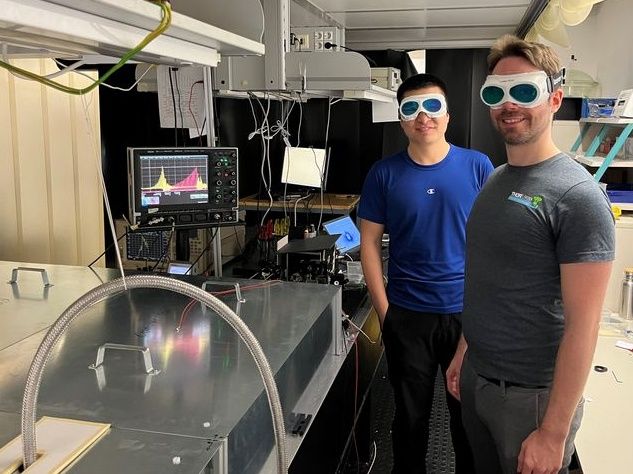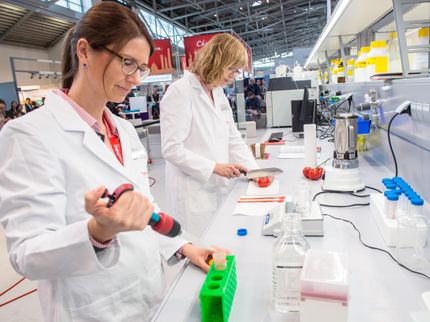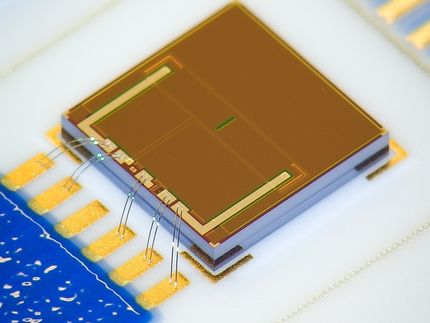Chemical analyses faster and more precise than ever before
A new spectroscopy method: Ultra-short light pulses enable high-precision "artificial nose"
Whether you want to analyze environmental samples in nature or monitor a chemical experiment, you often need highly sensitive sensors that can "sniff out" even tiny traces of a certain gas with extreme accuracy. Variants of Raman spectroscopy are often used for this purpose: Different molecules react in very characteristic ways to light of different wavelengths. If you irradiate a sample with the appropriate light and measure exactly how the light is modified by the sample, you can find out whether the sample contains a certain gas or not.

Hongtao Hu and Vinzenz Stummer
Technische Universität Wien
However, scientists at TU Wien (Vienna) has now taken a significant step forward in this area: a new method has been developed to generate and precisely control suitable light for such experiments. This not only enables much greater accuracy than before, the method also works without moving parts and is therefore much faster than the best technologies to date. The method has now been published in the journal "Light: Science and Applications".
Stimulated Raman emission: wobbling atoms
The basis of the new technology is so-called "stimulated Raman emission" - a quantum physical process in which several photons are involved simultaneously. A sample is irradiated with light that consists of two slightly different wavelengths. A molecule in the sample can therefore be hit simultaneously by two photons that carry slightly different amounts of energy. It can then happen that the high-energy photon and the lower-energy photon suddenly become two lower-energy photons - the remaining energy difference leads to the molecule suddenly having a little more energy than before. The atoms of the molecule can be stimulated to wobble or rotate, for example.
This means that the number of higher-energy photons has decreased and the number of lower-energy photons has increased. This is precisely how you can tell that the molecule you are looking for was actually in the sample.
"Normally, however, this is a laborious process," explains Hongtao Hu from the Institute of Photonics at TU Wien, the first author of the current paper. "You have to carefully try out one wavelength after another - for example, by directing the light at a crystal and then slowly rotating the angle or changing the temperature of the crystal so that the sample is hit by many different wavelengths over time."
Femtosecond laser pulses
At TU Wien, however, Prof. Andrius Baltuska's research group cooperated with Dr. Xinhua Xie from SwissFEL at Paul Scherrer Institute, Switzerland, and Prof. Alexei Zheltikov from the Department of physics and Astonomy at Texas A&M university, USA, to measure the Raman using a special light source. Andrius Baltuska's group had been working on this light source for years. Hongtao Hu and the co-authors have now been able to show through extensive computer simulations that it can achieve much higher precision than conventional methods. "We don't just produce one wavelength, but a series of ultra-short light pulses," explains Prof. Andrius Baltuska. "Each of these pulses has a duration in the femtosecond range."
These light pulse series do not have a specific wavelength - they are made up of many different wavelengths. The decisive factor is the phase of the light waves - i.e. the position of wave crests and troughs. "By changing the phase, we can shift all these wavelengths that make up the pulse a little at the same time," says Hongtao Hu. "You then get a Raman signal at very specific wavelengths, but not at others. Our method therefore allows us to examine a specific wave range in a very elegant way without having to adjust any moving parts. In principle, this allows us to differentiate between very different molecules."
Higher spectral resolution than ever before
Hongtao Hu was able to show: The longer the series of light pulses, the higher the precision: "You can therefore achieve a significantly higher spectral resolution with a series of many individual pulses than ever before," says Hongtao Hu. In principle, it is also possible to distinguish Raman transitions from each other that come from different molecules, whose signals looked almost exactly the same if the spectral resolution is not high enough. Possible applications for the new technology range from environmental analysis to quality assurance in the chemical industry and biological imaging.
Original publication
Other news from the department science
Most read news
More news from our other portals
See the theme worlds for related content
Topic World Spectroscopy
Investigation with spectroscopy gives us unique insights into the composition and structure of materials. From UV-Vis spectroscopy to infrared and Raman spectroscopy to fluorescence and atomic absorption spectroscopy, spectroscopy offers us a wide range of analytical techniques to precisely characterize substances. Immerse yourself in the fascinating world of spectroscopy!

Topic World Spectroscopy
Investigation with spectroscopy gives us unique insights into the composition and structure of materials. From UV-Vis spectroscopy to infrared and Raman spectroscopy to fluorescence and atomic absorption spectroscopy, spectroscopy offers us a wide range of analytical techniques to precisely characterize substances. Immerse yourself in the fascinating world of spectroscopy!

































































